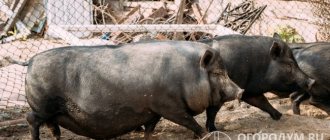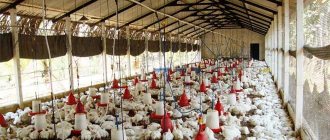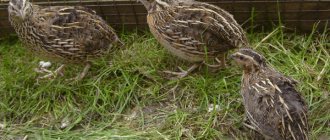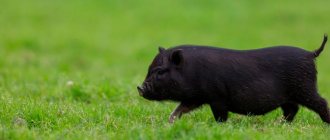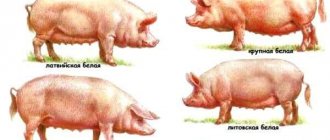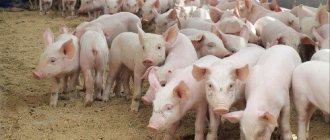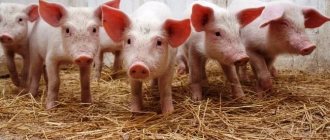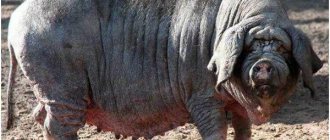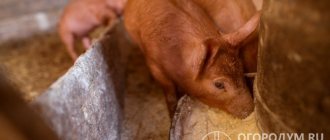In Russia, the Belarusian meat breed of pigs, along with black-and-white and large white, are the most famous. Belarus can rightfully be proud of its pig farming. There are over 100 industrial complexes in this industry on its territory. Continuous selection improvement of species and assessment of their compatibility are carried out. For this, the best genetic materials are used. They have developed their own breeds, intra-breed types and hybrids that are most adapted to local conditions.
Breeding is one of the main tasks
Over the past two decades, the pork industry in Belarus has generally functioned successfully. Unlike many countries of the former USSR, breeding centers for breeding animals have been preserved here and are currently actively developing. The country has research and zootechnical institutes engaged in hybrid activities and selection.
Recently, pigs bred on an interbreed basis (crossbreeds and hybrids) have been supplied to meat processing plants from the industrial sector. They are more adapted to production conditions and have better fattening and meat qualities. For this purpose, the world's best genotypes are taken.
Much work in pig farming is carried out to organize adequate feeding, develop requirements for the quality of feed and their components, and improve their structure.
Pig farming in Belarus
The increase in production volumes of livestock products, including pig breeding, in Belarus is proceeding more and more intensively. For our country, highly developed livestock farming has always been the basis for ensuring food security. Since this industry produces more than 65% of the value of gross agricultural output and the economic well-being of the majority of agricultural workers largely depends on its effective operation. organizations of the republic.
In the republic, all categories of farms produced about 7.0 million tons of milk and more than 1.8 million tons of meat (in live weight) in 2022. Per capita, 750,770 kg of milk and 120,130 kg of meat are produced annually.
The pig breeding industry is of decisive importance in the overall structure of livestock farming.
In the Republic of Belarus there are about 3.1 million pigs in all categories of farms, including 2.7 million in agricultural organizations, of which 390 thousand are in breeding farms.
Big, white and the most popular
The Belarusian Large White breed is the most common in its homeland (80%).
Its history goes back to the 19th century, to England, where local pigs were actively crossed with foreign ones from Italy, Portugal, and China. The first individuals of the resulting white pig were brought to Belarus in the 1930s, and only in the mid-1970s its new Belarusian type (BKB-1) was obtained.
The work continued, the Belarusian breed of pigs was improved. For example, the age to reach 100 kg has decreased from 200 days (1976) to 170 days (2015).
Pigs are distinguished by their large size, rapid growth, and reproduction. They have a strong constitution, a small head, erect ears, correctly positioned and strong legs. The skin has very light shades.
In their content, special attention should be paid to the temperature regime (it should be warm).
Features, origin and relationship
Black pigs within the breed are divided into three varieties in the context of farm breeding:
- sebaceous;
- meat;
- combined, that is, for obtaining meat and lard from one individual.
Through selective breeding, many breeds have been developed with different tones and shades of black color, but they are all united by more or less common characteristics:
- small head, but with large and floppy ears;
- against the background of the body, the back part appears saggy;
- an elongated oblong body with a specific structure of the hams - they are round, but the roundness ends at the hock joints;
- well developed, defined muscles;
- the meat mass of boars fluctuates around 350 kg, and for females up to 250 kg;
- strong and developed thoracic diaphragm;
- body length on average reaches 165-175 cm;
- There may be folds of skin on the legs and in the ham area.
It is believed that people who in the future want to start pig farming without having the skills should start breeding with this particular variety. First of all, this is due to the fact that the breed is unpretentious and quickly gains meat weight.
Based on eight different genotypes
The Belarusian meat breed appeared in the late 1990s.
The genes of eight breeds served as the material for its breeding. The breeders carried out intense and painstaking work using the methods of Russian specialists, who also worked hard on the meat representatives. For the first time, pigs that were very similar in both external and qualitative characteristics were crossed.
Distinctive features of the breed include a large litter at each farrowing (up to 12 piglets), high, as tastings show, meat and fat qualities, rapid growth (735-831 g every day), and resistance to infections.
Externally, Belarusian pigs look very large, muscular, with a developed rear part of the body. The head is relatively small, the back is slightly elongated. The skin is almost perfectly smooth and white.
black pig
Today, farm owners raise pigs for different purposes. Someone simply strives to feed their family with natural homemade meat. Someone receives considerable income from the sale of pork and piglets for breeding. Moreover, if not so long ago the number of breeds bred in our country reached 5-6, today their diversity has increased to several dozen. And the black pig is of particular interest to breeders.
Black breeds of pigs
Black pestles with earrings
The Belarusian black-and-white pig breed has existed for more than 40 years. To breed it, Tamworth, Landrace, large black and white pigs were used. There is some wild boar in it, which gives it stamina.
Pigs of this breed are distinguished by earrings - a kind of vestige passed down from their ancestors. They are spotted, very large (boars - up to 185 cm, females - up to 170 cm), proportionally developed, with high fertile qualities and undemanding to living conditions. Their reproductive system functions well, the safety of newborn piglets reaches 89-95%.
Black-and-white pigs are raised on both large farms and small private farms. In the summer, they happily absorb green matter and graze.
Because of this, the meat turns out marbled; it has repeatedly won prizes in tasting competitions. About this delicious product, read our article “Breeds of piglets for marbled pork.”
Advantages and disadvantages
Despite the fact that dark breeds of pigs differ from each other, it is possible to identify common advantages and disadvantages of the group. The benefits of breeding black pigs include:
- High fertility. Most representatives of the group have a good ability to reproduce: sows give birth to an average of 9–11 cubs.
- Unpretentiousness. Black pigs are omnivores and are not capricious in matters of nutrition.
- Good adaptation. Almost all breeds tolerate summer heat and winter cold well.
- Rapid weight gain. Most pigs gain weight quickly and are of impressive size.
- Versatility. The animals produce a good yield of meat and fat and are suitable for breeding work.
Farmers consider the main disadvantages of black pigs to be the animals’ excessive appetite, which is why they often suffer from obesity. In addition, each breed has individual flaws: for example, large black pigs have a pampered constitution.
Yorkshire Belarusian
The Yorkshire breed originates from England in the 19th century. Its representatives were brought to the territory of the USSR in the 1940-1950s.
Belarusian breeders pay a lot of attention to the development of this breed. Its hybrids were obtained by crossing Yorkshires with Landrace, Large White, and Belarusian meat. The results obtained with the last two types are considered especially successful.
In 2010, a type of Yorkshire breed was developed in Belarus - “Dneprobugsky”. The specialists managed to achieve the following indicators:
- multiple births - 11.5-12 piglets;
- piglet growth – up to 900 g per day;
- age of weight gain of 100 kg – 165-170 days;
- meat yield – 62-63%;
- Lard thickness is on average 20-22 mm.
Belarusian Yorkshire dogs have a body length of 162 cm for boars and 160.6 cm for sows. Their differences are erect ears, massive shoulders, strong legs and smooth skin. Read more about them in the article “Yorkshire pigs”.
Description of the breed
Photo 2
You can notice animals of this breed by their large build size with a well-developed rear (photo 1). This applies to both boars and sows.
The queens have twelve to fourteen large nipples, which are evenly spaced and have sharp outlines. Such distinctive features indicate multiple births (photo 2).
If we talk about the size of their head, it is not very large and quite light. The back is long and straight, the withers are level, the neck is of medium length. Pigs have muscular shoulders and rounded sides. The loin is slightly elongated, but level. The legs are positioned correctly and are strong. The skin is smooth and white. Boars have well-developed testes and strong bones. If we compare the Belarusian breed in terms of characteristic characteristics (for example, live weight) with other breeds, then in this case, undoubtedly, very strong arguments can be made in favor of the first. Completely different age categories have high rates.
Surpassed both “father” and “mother”
The Duroc breed is widespread in the United States. These are red pigs, quite large, with good adaptation to almost all climatic zones. They were brought to Belarus in 1987. Since then, continuous work has been carried out to create and improve the in-breed type (“Belorussky O-1”).
First of all, it was crossed with Belarusian Large White pigs, which increased a number of Duroc indicators (gain by 56-79 g, safety of piglets by 2-6%). These crosses produced the largest piglets.
In recent years, breeders have managed to increase the body length of pigs to the Elite class (for boars - up to 183 cm, for sows - up to 162 cm), and increase the rate of multiple births (up to 10.1 heads).
According to experts, the in-breed type of the Duroc breed obtained in Belarus is 5-9% superior to the purely domestic large white breed in many qualities.
Feedback from livestock farmers
Matvey, 37 years old, Saratov
In my experience, the most unpretentious to feed, resistant to disease, early maturing, prolific and dairy breeds are our proven breeds - Large White and Soviet Meat (SM-1). Of course, buying purebred piglets is not easy or cheap. We took several KB from a private farm - clean, well-fed, active, with a good appetite. Each piglet (two months old) weighed more than 25 kilos. If you buy on the market, then you should not expect any guarantees of compliance with breed standards and vaccinations.
Ekaterina, 44 years old, Kuzbass
If I feed them a complete diet, I like white pigs (promki) the best. In 6 months they reached 100-110 kg live. And the Vietnamese (we have mini pigs) – 40-50 kg. At the same time, the whites ate about 400 kg each, and the Vietnamese 200 kg each. The choice depends on the purpose of raising pigs: for yourself, for sale or as a hobby.
Nikolay, 52 years old, Vinnytsia region
Now real lard is in great short supply, and there is a dominance of meat breeds all around. But I believe that any animal has meat, but only pigs have lard, which is why I like white ones. We specially feed grain and potatoes so that the lard becomes thick (in some places as big as 4 fingers), soft, tasty, whether for yourself or for sale - it goes in great demand.
